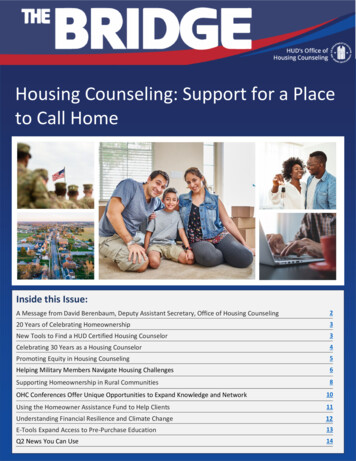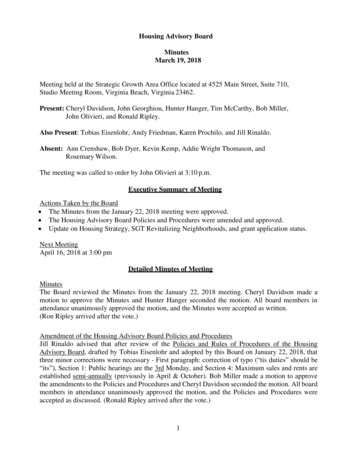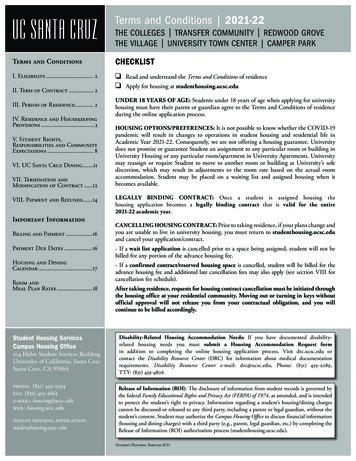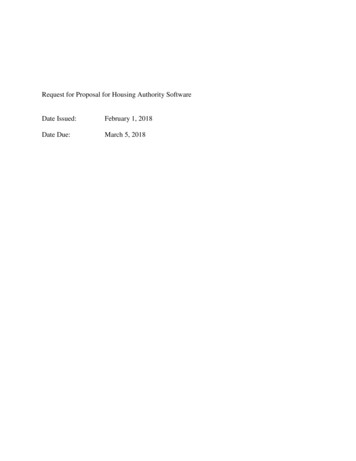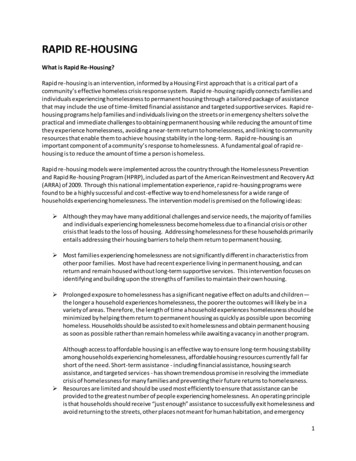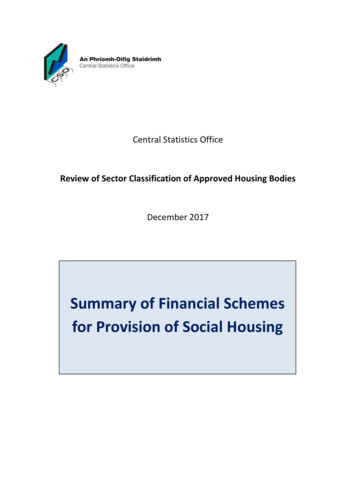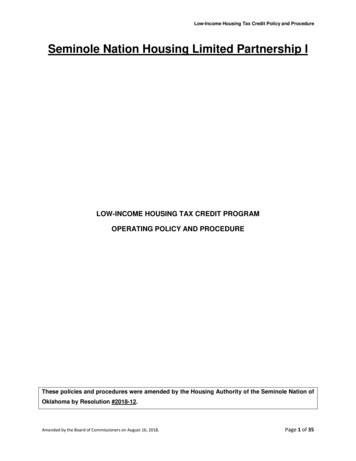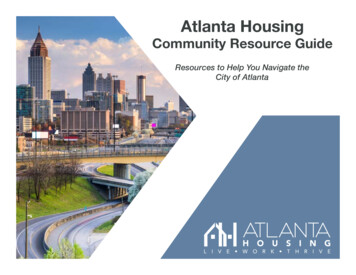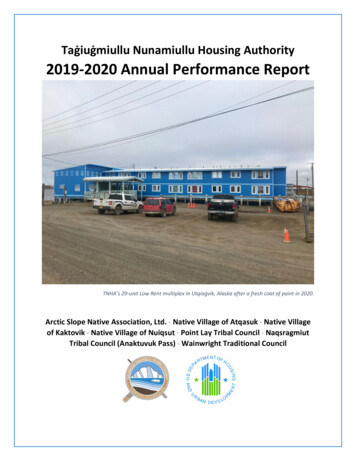
Transcription
Taġiuġmiullu Nunamiullu Housing Authority2019-2020 Annual Performance ReportTNHA’s 29-unit Low Rent multiplex in Utqiaġvik, Alaska after a fresh coat of paint in 2020.Arctic Slope Native Association, Ltd. ˑ Native Village of Atqasuk ˑ Native Villageof Kaktovik ˑ Native Village of Nuiqsut ˑ Point Lay Tribal Council ˑ NaqsragmiutTribal Council (Anaktuvuk Pass) ˑ Wainwright Traditional Council
SECTION 1: COVER PAGE55IH0201120(1) Grant Number:(2) Recipient Program Year:(3) Federal Fiscal Year: 7/1 - 6/302019(4)Initial Plan (Complete this Section then proceed to Section 2)(5)Amended Plan (Complete this Section and Section 8 if applicable)(6)Annual Performance Report (Complete items 27-30 and proceed to Section 3)(7)Tribe(8)TDHE(9) Name of Recipient:Taġiuġmiullu Nunamiullu Housing Authority(10) Contact Person:Griffin W. Hagle(11) Telephone Number with Area Code (999) 999-9999 :(907) 852-7160(12) Mailing Address:P.O. Box 409(13) City:(14) State:UtqiaġvikAlaska(15) Zip Code (99999 or 99999-9999):99723(16) Fax Number with Area Code (if available) (999) 999-9999 :(907) 852-2038(17) Email Address (if available):griffin.hagle@tnha.net(18) If TDHE, List Tribes Below:Arctic Slope Native Association, Ltd. (Arctic Slope Regional Corporation); Naqsragmiut Tribal Council(Anaktuvuk Pass); Native Village of Atqasuk; Native Village of Kaktovik; Nuiqsut Tribal Council; NativeVillage of Point Lay IRA Council; Wainwright Traditional Council.(19) Tax Identification Number:92-0074122(20) DUNS Number:007265437(21) CCR/SAM Expiration Date (MM/DD/YYYY):01/12/2020(22) IHBG Fiscal Year Formula Amount: 3,803,870(23) Name of Authorized IHP Submitter:Griffin W. HaglePage 1 of 39
Chief Executive Officer(24) Title of Authorized IHP Submitter:(25) Signature of Authorized IHP Submitter:(26) IHP Submission Date(MM/DD/YYYY) :04/15/2019(27) Name of Authorized APR Submitter:Griffin W. Hagle(28) Title of Authorized APR Submitter:Chief Executive Officer(29) Signature of Authorized APR Submitter:(30) APR Submission Date (MM/DD/YYYY):12/29/2020Certification: The information contained in this document is accurate and reflects the activities actually planned oraccomplished during the program year. Activities planned and accomplished are eligible under applicable statutesand regulations.Warning: If you knowingly make a false statement on this form, you may be subject to civil or criminal penalties underSection 1001 of Title 18 of the United States Code. In addition, any person who knowingly and materially violates anyrequired disclosure of information, including intentional disclosure, is subject to a civil money penalty not to exceed 10,000 for each violation.Page 2 of 39
ONE YEAR PLAN & ANNUAL PERFORMANCE REPORTSECTION 2: HOUSING NEEDSNAHASDA § 102(b)(2)(B)(1) Type of Need: Check the appropriate box(es) below to describe the estimated types of housing needs andthe need for other assistance for low-income Indian families (column B) and all Indian families (column C) insideand outside the jurisdiction.(A)Type of NeedCheck All That Apply(B)(C)Low-Income IndianFamilies(1)Overcrowded Households (2)Renters Who Wish to Become Owners (3)Substandard Units Needing Rehabilitation (4)Homeless Households (5)Households Needing Affordable Rental Units (6)College Student Housing (7)Disabled Households Needing Accessibility (8)Units Needing Energy Efficiency Upgrades (9)Infrastructure to Support Housing All Indian Families (10) Other (specify below)(2) Other Needs. (Describe the “Other” needs below. Note: this text is optional for all needs except “Other.”):Personal Finance and Credit Counseling/Repair; Down Payment and Closing Cost Assistance; Rental and Deposit Assistance;Small Upgrade Loans; Weatherization; Environmental Health Interventions; Building Science and Healthy Homes Education;Maintenance Counseling; Community Access to Building Materials; Technical Support for Independent Wastewater Systems(3) Planned Program Benefits. (Describe below how your planned programs and activities will address theneeds of low income families identified above. Also describe how your planned programs will address thevarious types of housing assistance needs NAHASDA § 102(b)(2)(B)):Taġiuġmiullu Nunamiullu Housing Authority (TNHA) will solicit written proposals and comments from its constituent tribes tostrategically develop and continuously improve its annual Indian Housing Plan (IHP). The IHP will aim to be responsive to thepresent and emerging needs of the region's low- and moderate-income American Indian/Alaska Native (AIAN) families withinthe funding constraints of the Indian Housing Block Grant (IHBG). Resources will be targeted to leverage new investment,strengthen partnerships, and enhance economies of scale at the local level. TNHA will do this through programs and servicesaligned with our mission statement, adopted November 8, 2018, "to excel in the delivery of opportunities for affordablehousing that empower, build, and sustain vibrant self-determined communities on the Arctic Slope for generations to come."TNHA will advocate for the establishment of a regional coalition to address housing and homelessness issues in partnershipwith regional and local municipalities, tribal governments, Native corporations, groups, individuals, and policymakers. ThisPage 3 of 39
coalition will meet on a regular basis to explore new ways of working together, facilitate information sharing, coordinate andstreamline service delivery, build capacity, and attract the resources essential to address local and regional housing needs.TNHA will champion the importance of participation in the 2020 U.S. Census to the communities it serves and coordinatingagencies, and participate in regional and local comprehensive planning efforts to assure efficient utilization of resources,including health care, water and sewer, energy, transportation, education and training, economic development, and shelter.Through its membership in the Association of Alaska Housing Authorities, TNHA will engage state and federal policymakers invigorous advocacy for the housing needs and interests of the Arctic Slope. TNHA will also publish a regular newsletter anduse appropriate media resources, including press releases, newspaper advertisements, and social media platforms, todisseminate timely updates on its programs and activities to its constituent tribes and the general public on a regular basis.TNHA's occupancy department will continue to deliver a high standard of service in operating its legacy affordable housingprograms, to include those activities prescribed by NAHASDA or subject to contract between the Secretary and the IndianHousing Authority pursuant to the United States Housing Act of 1937. To the extent permitted by NAHASDA and feasible atcurrent funding levels, TNHA will also develop and offer new programs and services, to include down payment and closingcost assistance, rental and deposit assistance, small home upgrade loans, and personal finance/credit counseling.TNHA's operations department will continue to utilize the force-account method to complete the modernization of 1937 ActCurrent Assisted Stock units in order to preserve and maintain the viability of affordable housing throughout the region. Inconsideration of funding limitations, TNHA will prioritize three key project areas: Life, Health, and Safety Repairs; EnergyEfficiency and Indoor Environmental Quality (including Room-to-Room Pressure Balancing, Heat-Recovery VentilationImprovements, and Elimination of Atmospheric Combustion Appliances); and Cost-Effective Renewable Energy Systems.Routine, preventative, and non-routine maintenance shall be provided by TNHA for all of its Low Rent stock. Outside offunded modernization projects, routine or preventative maintenance shall not be provided by TNHA for other units.Emergency and non-routine work on Mutual Help and NAHASDA homes may be provided to homebuyers at cost, as acourtesy, in recognition of the limited economies and access to skilled tradespeople prevalent in the outlying villages of theArctic Slope. The cost of any emergency and non-routine assistance provided to Mutual Help and NAHASDA homes utilizingTNHA employees under this provision shall be disclosed in advance to, and borne by, the homebuyer.(4) Geographic Distribution. Describe below how the assistance will be distributed throughout the geographicarea and how this geographic distribution is consistent with the needs of low income families. NAHASDA §102(b)(2)(B)(i)):TNHA owns and operates approximately 270 affordable housing units across the eight villages of the North Slope Borough,including 107 low-income rentals in the regional hub of Utqiaġvik, 43 NAHASDA-assisted homebuyer units in the six outlyingvillages for which TNHA is the TDHE (Anaktuvuk Pass, Atqasuk, Kaktovik, Nuiqsut, Point Hope, Point Lay, and Wainwright), and83 Mutual Help units distributed across all eight villages. Additionally, TNHA separately operates 112 units of market-basedpublic rental housing in Utqiaġvik. Income from this program is used to support affordable housing programs and services.Analysis of data from the 2010 U.S. Census reveals that there were 1,768 persons of AIAN heritage residing in the six (6) ArcticSlope villages for which TNHA is the TDHE. The HUD FY 2019 IHBG Estimated Allocation for these villages counts a total of1,774 AIAN persons. The Census counts 5,512 AIAN persons for the North Slope Borough Census Area overall, which includesthe regional hub of Utqiaġvik and the large village of Point Hope, while HUD estimates 4,900 AIAN total persons. Dependingon the data source used, TNHA is the TDHE for approximately 32-36% of the regional AIAN population.Even a cursory review of occupancy patterns and quality of life in the region reveals dramatic need. The 2018 Alaska HousingAssessment estimates 27 percent of occupied units in the North Slope Borough census area are either "overcrowded" or"severely overcrowded." This is more than eight times the national average, and distinguishes the North Slope Borough as thefifth most overcrowded census area in the state. As a community leader testified during a field hearing of the U.S. SenateCommittee on Indian Affairs held in the Bering Straits village of Savoonga in August 2018, "For American Indians and AlaskaNatives, overcrowded housing is a manifestation of what would be unsheltered homelessness in other parts of the country."Provision of new and rehabilitated affordable housing for low-income AIAN families remains TNHA's top priority. Beginningwith this IHP cycle, TNHA will implement a new community-driven needs assessment and program proposal processPage 4 of 39
designed to equitably distribute opportunity to direct investment of pooled resources among the six villages for which it isthe TDHE. The needs assessment will take the form of a simple electronic matrix which tribal partners can populate withhousehold contact information and check boxes reflecting each household's need. The program proposal, adapted from asimilar tool used by Tlingit-Haida Regional Housing Authority, will allow tribal partners to submit requests for considerationto TNHA for review by the TNHA Board of Commissioners. Final determination of which proposals, if any, will be incorporatedinto the following IHP cycle will be by consensus of the BOC, TNHA management, and tribal partners, and based uponanalysis of a complete community-driven needs assessment, current census area data, comprehensive planning data, historicpatterns of resource utilization by geographic region, availability of other leveraging resources, timeliness, and other factors.TNHA's 2019 IHP establishes the following general priorities for the distribution of regional resources: 1) Modernize andadvance the sustainability of legacy current assisted stock (1937 Act housing), and, 2) within NAHASDA funding, regulatory,and policy constraint, address life, health, and safety deficiencies. Low-income AIAN families residing in a TNHA-affiliatedvillage in substandard or overcrowded housing will receive the highest preference. Priority will, as always, be establishedaccording to the age of the units and assessment indicating severity of need.In this manner, all current assisted stock units in villages throughout the region will have an equitable opportunity for servicewith overall 2019 IHBG funding distributed in a manner proportional to need and consistent with NAHASDA formulaallocation for the current year. While provision of affordable housing to low-income AIAN families remains TNHA's firstpriority, should housing needs be identified for families who do not meet affordable housing eligibility requirements, TNHAwill provide referral to other appropriate regional resources.Page 5 of 39
SECTION 3: PROGRAM DESCRIPTIONS[102(b)(2)(A)], [233(a)], [235(c)], [404(b)], 24 CFR §1000.512(b)(2) and (3)Planning and Reporting Program Year ActivitiesIn this section, the recipient must provide a description of its planned eligible activities, and intendedoutcomes and outputs for the One-Year IHP. The recipient can select any combination of activitieseligible under NAHASDA and intended outcomes and outputs that are based on local needs andpriorities. There is no maximum or minimum number of eligible activities or intended outcomes andoutputs. Rather, the One-Year IHP should include a sufficient number of eligible activities andintended outcomes to fully describe any tasks that the recipient intends to fund in whole or in partwith IHBG resources during the coming program year.Subtitle B of NAHASDA authorizes recipients to establish a program for self-determined housingactivities involving construction, acquisition, rehabilitation, or infrastructure relating to housingactivities or housing that will benefit the low-income households served by the Indian tribe. Arecipient may use up to 20 percent of its annual allocation, but not more than 2 Million, for thisprogram. Section 233(a) of NAHASDA requires a recipient to include its planned self-determinationprogram activities in the IHP, and Section 235(c) requires the recipient to report the expenditures,outputs, and outcomes for its self-determination program in the APR. For more information, see PIHNotice 2010-35 (Demonstration Program - Self-Determined Housing Activities for Tribal Governments)at d DOC 8814.pdfThe One-Year IHP is not required to include eligible activities or intended outcomes and outputs thatwill not receive IHBG resources. For example, the recipient may be planning to apply for Low IncomeHousing Tax Credits (LIHTC) from its state. If those tax credit projects will not receive IHBG resources,they are not required to be described in the IHP. However, the recipient may wish to include nonIHBG activities in the IHP to provide tribal members with a more complete picture of housing activities.If an activity will receive partial funding from an IHBG resource, it must be described in the IHP.For example, if the recipient uses IHBG-funded staff persons to manage, inspect, or maintain an LIHTCfunded rental project, that project would be considered an IHBG-assisted project and the relatedactivities must be described in the IHP.Planning and Administrative expenses and loan repayments should not be identified as programs inthe IHP. That is why there are dedicated rows in the Uses of Funding budget for these expenses.Instead, describe anticipated planning and administrative expenses in Section 6, Line 4 of the IHP, anddescribe actual planning and administration expenses in Section 6, Line 5 of the APR. Report theplanned and actual amount of planning and administrative expenses in the dedicated row of the Usesof Funding budget (Section 5, Line 2). Please note that Reserve Accounts to support planning andadministration is an eligible activity and should be identified as a program in the IHP, and any plannedor actual expenditure from the Reserve Account would be reported by its program name in the Usesof Funding table.For the IHP, complete the unshaded sections to describe the planned activities, outcomes and outputsin the coming 12-month program year. The recipient must complete Lines 1.1 through 1.4, Lines 1.6and 1.7, and Line 1.9 for each eligible activity or program planned for the One-Year IHP. For the APR,complete the shaded sections to describe actual accomplishments, outcomes, and outputs for theprevious 12-month program year. In particular, complete Lines 1.5, 1.8, 1.9, and 1.10 for each programincluded in the IHP.Page 6 of 39
Eligible Activity May Include (citations below all reference sections in NAHASDA)Eligible ActivityOutput MeasureOutput Completion(1) Modernization of 1937 Act Housing [202(1)]UnitsAll work completed and unit passed final inspection(2) Operation of 1937 Act Housing [202(1)]UnitsNumber of units in inventory at Program Year End(PYE)(3) Acquisition of Rental Housing [202(2)]UnitsWhen recipient takes title to the unit(4) Construction of Rental Housing [202(2)]UnitsAll work completed and unit passed final inspection(5) Rehabilitation of Rental Housing [202(2)]UnitsAll work completed and unit passed final inspection(6) Acquisition of Land for Rental HousingDevelopment [202(2)]AcresWhen recipient takes title to the land(7) Development of Emergency Shelters [202(2)]HouseholdsNumber of households served at any one time,based on capacity of the shelter(8) Conversion of Other Structures to AffordableHousing [202(2)]UnitsAll work completed and unit passed final inspection(9) Other Rental Housing Development [202(2)]UnitsAll work completed and unit passed final inspection(10) Acquisition of Land for Homebuyer UnitDevelopment [202(2)]AcresWhen recipient takes title to the land(11) New Construction of Homebuyer Units [202(2)]UnitsAll work completed and unit passed final inspection(12) Acquisition of Homebuyer Units [202(2)]UnitsWhen recipient takes title to the unitUnitsWhen binding commitment signedUnitsWhen binding commitment signedUnitsWhen binding commitment signed(13) Down Payment/Closing Cost Assistance[202(2)](14) Lending Subsidies for Homebuyers (Loan)[202(2)](15) Other Homebuyer Assistance Activities[202(2)](16) Rehabilitation Assistance to ExistingHomeowners [202(2)]UnitsAll work completed and unit passed final inspection(17) Tenant Based Rental Assistance [202(3)]HouseholdsCount each household once per year(18) Other Housing Service [202(3)]HouseholdsCount each household once per year(19) Housing Management Services [202(4)](20) Operation and Maintenance of NAHASDAAssisted Units [202(4)]HouseholdsCount each household once per yearUnitsNumber of units in inventory at PYEDollarsDollars spent (report in Uses of Funding table only)(21) Crime Prevention and Safety [202(5)]Page 7 of 39
(22) Model Activities [202(6)]DollarsDollars spent (report in Uses of Funding table only)AcquisitionUnitsWhen recipient takes title to the unitConstructionUnitsAll work completed and unit passed final inspectionRehabilitationUnitsAll work completed and unit passed final inspectionInfrastructureDollarsDollars spent (report in Uses of Funding table only)DollarsDollars spent (report in Uses of Funding table only)N/AN/A(23) Self-Determination Program [231-235](24) Infrastructure to Support Housing [202(2)](25) Reserve Accounts [202(9)]Outcome May Include:(1) Reduce over-crowding(7) Create new affordable rental units(2) Assist renters to become homeowners(8) Assist affordable housing for college students(3) Improve quality of substandard units(9) Provide accessibility for disabled/elderly persons(4) Improve quality of existing infrastructure(10) Improve energy efficiency(5) Address homelessness(11) Reduction in crime reports(12) Other – must provide description in boxes 1.4 (IHP) and 1.5(APR) below(6) Assist affordable housing for low income householdsIHP: PLANNED PROGRAM YEAR ACTIVITIES (NAHASDA § 102(b)(2)(A))For each planned activity, complete all the non-shaded sections below. It is recommended that for each programname you assign a unique identifier to help distinguish individual programs. This unique number can be anynumber of your choosing, but it should be simple and clear so that you and HUD can track tasks and resultsunder the program and collect appropriate file documentation tied to this program. One way to number your programs is chronologically. For example, you could number your programs 2011-1,2011-2, 2011-3 etc. Or, you may wish to number the programs based on type. For example rental 1, rental 2, homebuyer1,homebuyer 2 etc. This type of numbering system might be appropriate if you have many programs that last over several years. Finally, you may wish to use an outline style of numbering. For example, all programs under your firsteligible activity would start with the number 1 and then be consecutively numbered as 1.1, 1.2, 1.3 etc.Page 8 of 39
APR: REPORTING ON PROGRAM YEAR PROGRESSComplete the shaded section of text below to describe your completed program tasks and actual results. Only report onactivities completed during the 12-month program year . Financial data should be presented using the same basis of accountingas the Schedule of Expenditures of Federal Awards (SEFA) in the annual audit. For unit accomplishments, only count units whenthe unit was completed and occupied during the year. For households, only count the household if it received the assistanceduring the previous 12-month program year. (NAHASDA § 404(b))1.1. Program Name and UniqueModernization of Current Assisted Stock 2019-1Identifier:DMD 2019-11.2. Program Descriptionprogram.):(This should be the description of the plannedTNHA will continue to modernize current assisted stock developed under the 1937 Housing Act to ensure thelong-term viability of affordable housing units in safe, decent, and sanitary condition. Project areas include Life,Health, and Safety Repairs; Energy Efficiency and Indoor Environmental Quality; and Cost-Effective RenewableEnergy Systems, where feasible. The oldest units and those near conveyance will receive priority service.Modernization activities may include repairs, retrofits, and improvements to: electrical systems; roofing; buildingenvelope and insulation; mechanical and heating systems; building structure and accessibility; fixtures andfurnishings; foundations; potable water and sewage system connections, and other building components.Project scopes will be designed to optimize indoor environmental quality and reduce consumption of costlyfossil fuels, and to that end may also include environmental health assessments and interventions, integrationof cold-climate heat pumps and solar photovoltaic systems, and telemetry to relay building performance data.1.3.1.3. EligibleEligible ActivityActivity NumberNumber (Select one activity from the Eligible Activity list. For any activityinvolving housing units as the output measure (excluding operations and maintenance), do notcombine homeownership and rental housing in one activity, so that when housing units arereported in the APR they are correctly identified as homeownership or rental.):(1) Modernization of 1937 Act Housing [202(1)]1.4. Intended Outcome Number (Select one outcome from the Outcome list. Each programcan have only one outcome. If more than one outcome applies, create a separate program foreach outcome.):(3) Improve quality of substandard unitsDescribe Other Intended Outcome (Only if you selected "Other" above):1.5 ActualActual OutcomeOutcome NumberNumber1.5(In the APR identify the actual outcome from the Outcome list.):(3) Improve quality of substandard unitsDescribe Other Actual Outcome (Only if you selected "Other" above.):1.6 Who Will Be Assisted (Describe the types of households that will be assisted under the program.Please note: assistance made available to families whose incomes fall within 80 to 100 percent of themedian must be included as a separate program within this section.):Low-income residents eligible for 1937 Act Housing (Low Rent and Mutual Help)1.7. Types and Level of Assistanceto each household, as applicable.):(Describe the types and the level of assistance that will be providedThe types and level of assistance provided will vary based on individual household needs and physical condition ofunits. TNHA operations will develop project budgets and force-account crews will perform the modernization work.Household eligibility determination will be conducted in accordance with TNHA admissions and occupancy policies.Page 9 of 39
1.8. APR: Describe the accomplishments for the APR in the 12-month program year. In accordance with24 CFR § 1000.512(b)(3), provide an analysis and explanation of cost overruns or high unit costs.Blower door, zonal pressure, and boiler tests conducted to determine home air leakage and combustion safety ofhomebuyer units in Anaktuvuk Pass, Atqasuk, Kaktovik, Utqiaġvik. Nuiqsut, Point Lay, and Wainwright, followed byinstallation and balancing of heat-recovery ventilators, boiler tuning, and final testing. Began procurement andexterior upgrade work on 29-unit rental multiplex in Utqiaġvik.1.9: Planned and Actual Outputs for 12-Month Program YearPlanned Number of Units to beCompleted in Year Under this ProgramPlanned Number Planned Number of Acres To Beof Households Purchased in Year Under this ProgramTo Be Served inYear Under thisProgram30APR: Actual Number of Units Completed APR: Actualin Program YearNumber ofHouseholdsServed inProgram YearAPR: Actual Number of AcresPurchased in Program Year211.10: APR:If the program is behind schedule, explain why. (24 CFR § 1000.512(b)(2))Severe cold spells over winter 2019-2020 created numerous life, health, and safety concerns in North Slope villages.Staff were taken off of project work and deployed to assist in resolving numerous frozen sewer and water systems atvarious times. Pandemic-related disruptions curtailed most staff travel to villages from March 2020 onward.Page 10 of 39
2.1. Program Name and UniqueManagement of Current Assisted Stock 2019-2Identifier:DHM 2019-22.2.1.2. Program Descriptionprogram.):(This should be the description of the plannedTNHA will continue to market and manage its legacy affordable housing programs developed under the 1937Housing Act, namely the Low Rent and Mutual Help programs. This includes public advertisement of theprograms, eligibility determination, timely recertification of participants' incomes, collection of tenant andhomebuyer payments, wait list management, processing work order requests, maintaining and digitizingrecords, and implementing the tenant selection process in accordance with TNHA policies.2.3.1.3. EligibleEligible ActivityActivity NumberNumber (Select one activity from the Eligible Activity list. For any activityinvolving housing units as the output measure (excluding operations and maintenance), do notcombine homeownership and rental housing in one activity, so that when housing units arereported in the APR they are correctly identified as homeownership or rental.):(2) Operation of 1937 Act Housing [202(1)]2.4.1.4. Intended Outcome Number (Select one outcome from the Outcome list. Each programcan have only one outcome. If more than one outcome applies, create a separate program foreach outcome.):(6) Assist affordable housing for low income householdsDescribe Other Intended Outcome (Only if you selected "Other" above):1.5 ActualActual OutcomeOutcome NumberNumber2.5(In the APR identify the actual outcome from the Outcome list.):(6) Assist affordable housing for low income householdsDescribe Other Actual Outcome (Only if you selected "Other" above.):2.61.6 Who Will Be Assisted (Describe the types of households that will be assisted under the program.Please note: assistance made available to families whose incomes fall within 80 to 100 percent of themedian must be included as a separate program within this section.):Low-income AIAN residents eligible for 1937 Act Housing (Low Rent and Mutual Help).2.7.1.7. Types and Level of Assistanceto each household, as applicable.):(Describe the types and the level of assistance that will be providedTNHA will provide affordable housing management services in the eight villages across the Arctic Slope where 1937Act stock exists with intent to promote the self-sufficiency of eligible tenants, homebuyers, and applicants.1.8. APR: Describe the accomplishments for the APR in the 12-month program year. In accordance with2.8.24 CFR § 1000.512(b)(3), provide an analysis and explanation of cost overruns or high unit costs.TNHA continued to support its managed housing in all villages to the extent capacity allowed. Zero vacancy rate invillage homebuyer units was maintained for over a year. Internally promoted a housing manager.Page 11 of 39
2.9: Planned and Actual Outputs for 12-Month Program YearPlanned Number of Units to beCompleted in Year Under this ProgramPlanned Number Planned Number of Acres To Beof Households Purchased in Year Under this ProgramTo Be Served inYear Under thisProgram190APR: Actual Number of Units Completed APR: Actualin Program YearNumber ofHouseholdsServed inProgram YearAPR: Actual Number of AcresPurchased in Program Year1901.10: APR:2.10:If the program is behind schedule, explain why. (24 CFR § 1000.512(b)(2))Staff turnover in housing division. Prolonged cold spells redirected resources over winter. Pandemic-relateddisruptions from March 2020 onward. Housing manager position not filled until April 2020.Page 12 of 39
3.1. Program Name and UniqueInspection of Current Assisted Stock 2019-3Identifier:DHM 2019-33.2.1.2. Program Descriptionprogram.):(This should be the description of the plannedTNHA will assure that periodic move-in, move-out, and special inspections as needed are conducted inaccordance with TNHA policy.3.3.1.3. EligibleEligible ActivityActivity NumberNumber (Select one activity from the Eligible Activity list. For any activityinvolving housing units as the output measu
2019-2020 Annual Performance Report . TNHA's 29-unit Low Rent multiplex in Utqiaġvik, Alaska after a fresh coat of paint in 2020. . Arctic Slope Native Association, Ltd. (Arctic Slope Regional Corporation); Naqsragmiut Tribal Council (Anaktuvuk Pass); Native Village of Atqasuk; Native Village of Kaktovik; Nuiqsut Tribal Council; Native .

